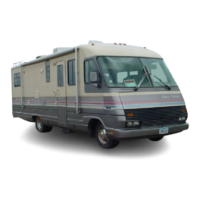VEHICLE
LOAD
CAPACITY
-
WEIGHING
Your
motor
home
is
designed to carry
the
loads defined
by
the
Gross Axle Weight Rating (GAWR)
and
Gross
Vehicle Weight Rating
(GVWR) shown
on
the
certifica-
tion tag posted
on
or
near
the
left edge
of
the
instru-
ment
panel. These ratings are for a fully-loaded vehicle
including passengers and normal belongings.
NOTE: Exceeding
the
GAWR
or
GVWR
of
your
motor
home
can cause undesirable hand-
ling
characteristics
and
may even create
a safety
hazard~
_ Modification
of
your
,vehicle
I1Y,.additi
Cl
nof
racks
hotspeci-
'ifiedby'ihe'manufacturer
to
ca'rrY
add-
itional-
equipment
or
vehicles
is
not
re-
commended and may
make
yoLirwarran'
ty
inapplicable.
Periodically weigh
the
motor
home
at
apublic
scale
to
-
determine
axle loads.
The
following
procedure
is
sug-
gested,
although any
method
recommended
by
the
scale
operator
which correctly determines weight values is-ac-
ceptable. During all measurements, it is
important
that
the
vehicle
be
kept
as level as possible.
1. R un only
the
front
wheels
onto
the
scale plat-
form and
obtain
a reading. (This first value
is
the
front
axle Gross Axle Weight.)
2.
Next, place the
entire
vehicle (both axles) on
the scale and
obtain
a reading. (This second
value is Gross Vehicle Weight.)
3. Drive forward until
only
the
rear axle
is
on
the
platform
and
obtain
a reading. (This
third reading
is
rear axle Gross Axle Weight.)
4.
Compare reading 2 with
the
GVWR
of
your
vehicle. If this reading exceeds
the
GVWR
rating,
it
will be necessary
to
reduce
total
vehicle load.
5.
-
If
reading 2
is
less
tharl'the
GVWR
of
your
vehicle,
check
readings
1 and 3
to
verify
that
. , each, is less
than
the
GAWR
on
the
certifica-
- tion tag. If
either
exceeds
the
GAWR
for
the
axle,i,
redistribute,enough',equipment
from
,front
to
back
or
the
reveise
to
ensure
that
- loads
on
front'
and
rear axles are
within
the
required limit.
Check vehicle weight periodically
to
obtain
optimum
mileage from tires
and
improved handling. Tires
should
always be inflated as
recommended
in
the
Chassis Man-
ufacturer's
Instructions. See
your
Chassis
Operator's
Manual.
READY
TO
LEAVE
The following suggestions may be helpful
when
you
are
ready
to
leave. (BE SURE TO PLACE THE ENTRY
STEP
IN
TRAVEL
POSITION.)
STARTING
AND WARMUP
For
best results, always follow the
recommendations
in
your
Chassis Operator's Manual when starting
or
opera-
ting
your
engine.
NOTE:
Be
sure transmission
is
in
neutral
and parking
brake
is
engaged
to
keep
the
motor
home
from rolling. If
the
parking
brake
needs ad-
justment,
see
the
Chassis
Operator's
Manual
for proper
adjustment
instructions.
SAFETY
BELTS
Seat
belts are an
important
safety feature
of
your
vehi-
cle.
For
your
protection,
it
is
required
that
all belts be
fastened while
your
motor
home
is
in
motion.
The
dri-
ver's seat and all
other
seats designed
to
carry passen-
gers,
while
under
way, have been
equipped
with a total
of
six safety belts.
belt, as shown in Figure 3. Holding
the
buckle in
this
position permits
the
belt
to
slide through. Pull
on
the
buckle until
the
desired length is
obtained.
To
fasten
the
belts, make sure
the
belts are
not
twisted,
then
push
the
tongue
end
of
one
belt
into
the
buckle
of
the
mating
belt.
Be
sure
it
goes in
all
the
way and
that
it
latches.
Tighten by
pulling
the
loose
end
of
the
belt
while hold-
ing
the
buckle.
Adjust
the
belt
as low
on
the
abdomen
and as snug as
comfort
will allow for greatest safety.
Never use a belt
for
more
than
one
person
at
a time.
NOTE: If
your
belts have been equipped
with
retrac-
tors, be
sure
belt
is
pulled
all
the
way
out
of
retractor.
NOTE: Seats which are
not
equipped
with
safety'"
belts should
not
be occupied while vehicle
is
TO
ADJUST
HAT
aeL
TS
in
motion
and will be labeled:
"NOT
F.OR
USE WHILE VEHICLE
IS
IN
MOTION."
Safety
belts are adjusted in
the
following manner: To
lengthen
the
belt,
tip
the
buckle
at
right angles
to
the
FIGURE 3 SAFETY BELT ADJUSTMENT
4

